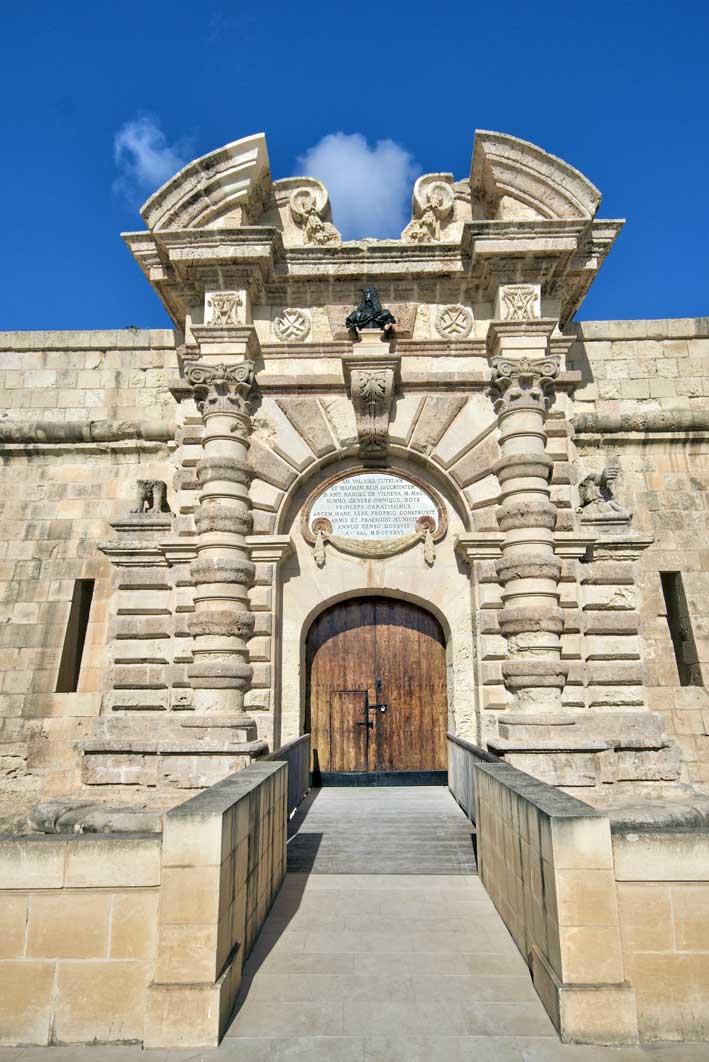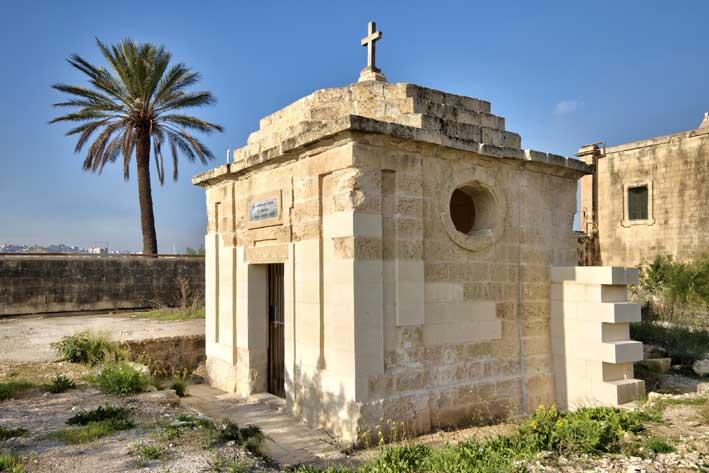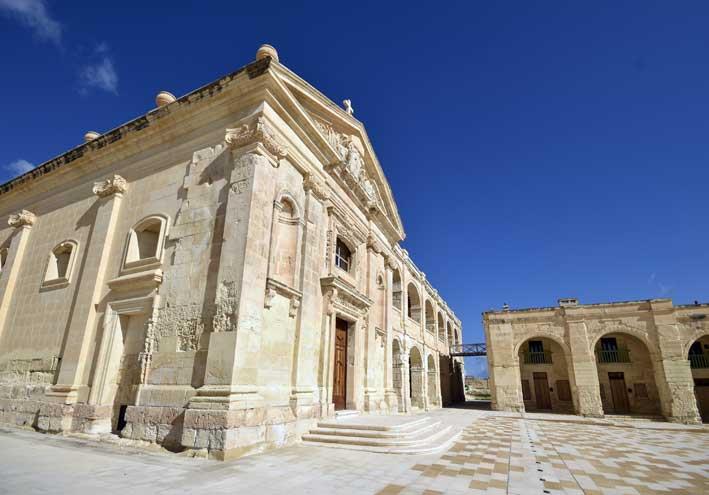Manoel Island stands as a testament to Malta's rich and colourful past. From its magnificent Fort Manoel to the iconic Lazzaretto, the buildings and sites that dominate the island are of national significance - so, their restoration and conservation are central to MIDI's revised Manoel Island Masterplan.
PRIORITISING HERITAGE
Before any restoration works began on Manoel Island, extensive research needed to be carried out. Previously undiscovered sites of archaeological importance were subsequently revealed, as well as deeper detail about the history of the island's heritage buildings.
Over the centuries, Manoel Island has served Malta's needs from the military to the sanitary. This varied past remains visible in each of its heritage buildings, which the revised Manoel Island Masterplan sustains and honours in its vision for their integration into the island's future.

The main gate is protected by a lunette known as the Couvre Porte.
FORT MANOEL
Fort Manoel is an architectural gem constructed by the Knights of the Order of St John in the early 1700s when the newly elected Grand Master, Antonio Manoel de Vilhena offered to finance the new fort out of his own pocket. Charles François de Mondion, the Order's resident engineer, was entrusted with the design of the new fort. Mondion effectively adopted Tigné's earlier design but added some new and unique features. The foundation stone was laid on 14th September 1723 and works progressed at a swift pace, such that the main gate was completed by 1726. The fort has a symmetrical square layout broken by four corner bastions. A large gun powder magazine was constructed on each of the sea-facing bastions while two low cavaliers joined by a curtain wall provided an added protection to the land front. In 1761 Bourlemaque described it as a model of a fortification, built with great attention and finished with every detail.
During WWII, the fort suffered from some direct hits which resulted in significant damage. A long stretch of the land front casemated barracks, the church dedicated to St. Anthony of Padova, and sections of barrack blocks were razed to the ground.
Considerable works have already been carried out on Fort Manoel to restore it to its former glory. The Manoel Island Masterplan proposes adapting the fort's restored buildings into a new arts and cultural centre which will include activities such as museums, interpretation centre, conference centre and other ancillary uses.
THE LAZZARETTO
Although commonly referred to as a single edifice, the former hospital on Manoel Island is a complex of separate but interconnected buildings, varying in age. The oldest parts are the ground floor of the Lazzaretto terrace, consisting of an arched elevation rising sheer from the sea - the hospital's most conspicuous feature.
The main building took on its present form under the grand masterships of Nicholas Cotoner, Gregorio Carafa and Manoel de Vilhena, and would serve as Malta's official quarantine hospital in times of cholera, plague and other epidemics for over 250 years. Among the more notable "guests" to have sojourned at the Lazzaretto during this period was the romantic poet Lord Byron, who lodged there on his way back from cholera-ridden Greece in 1811, as well as the young Cardinal Newman.
Although the need for a quarantine and isolation hospital subsided greatly in the 20th century, the Lazzaretto continued to be administered by the Maltese health authorities until 1939, when the building was taken over by the British Admiralty and converted for military use during World War II.
Although badly damaged and never fully repaired, the Lazzaretto hospital was nonetheless re-opened shortly after the war, admitting its first patients in 1949. However, the departure of the British Navy in the 1970s spelt an end to the Lazzaretto's use.
In view of the present state of the Lazzaretto, the task facing the restorers is considerably daunting. Parts of the original building which were either destroyed or dismantled are scheduled to be rebuilt in line with the original designs.
Through the Masterplan, the building will be completely restored and continue receiving visitors for entertainment and hospitality purposes.

St George's Chapel, Manoel Island.
THE CATTLE SHED AND BOVILE WAY
While people visiting Malta would quarantine at the Lazzaretto, livestock was taken to the Cattle Shed, Manoel Island's oldest building.
The old cattle shed was constructed by the Order of St. John during the first phase of construction of the Lazzaretto. Several new buildings which included stores, sheds and a small church dedicated to St. Rocco were erected on the south side of the foreshore soon after 1643 with further buildings and accommodation constructed in 1647.
Despite its poor state of preservation, the building survived and continued to be used for the quarantine of cattle arriving at the Lazzaretto even after 1800. The animals were accommodated at ground floor level while the apartments at first-floor level were reserved for the fodder and cattle dealers. The building envelope remained largely unchanged but occasional interventions were carried out to the building in order to adapt it for the particular needs of the time.
During WWII the building suffered substantial damage and most of the roofs collapsed. Little remains of the Cattle Shed's original isolation pens and walls, or the dedicated walled route that originally connected the building to the docks. The Manoel Island Masterplan aims to reconstruct both to reinstate their memory. The large internal open space of the Cattle Shed lends itself to be used for commercial activities on the island.

The chapel dedicated to St Anthony of Padua, Manoel Island.
THE PAY OFFICE AND GUARD HOUSE
Research into Manoel Island's heritage identified additional cultural assets such as the World War II-era Pay Office and the Guard House. Although these buildings were not previously being considered for retention, the revised Masterplan has safeguarded them and plans to restore them.
A MANOEL ISLAND FOR MALTA
By focusing on the heritage assets on Manoel Island, the revised Masterplan represents a new way of preserving Malta's history for the benefit of its residents and visitors. Using private rather than public funds, Manoel Island's historical assets will be fully renovated and curated. The revised Masterplan for Manoel Island will blend history with the contemporary world to become a new destination for locals while keeping Malta firmly placed on the world map.
For more information about the new MIDI Manoel Island Masterplan, visit www.manoelisland.com.mt